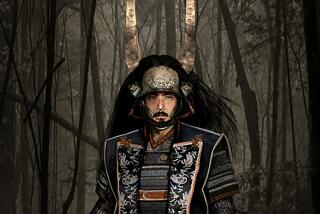A manga draws power from Iraq plotline
- Share via
In America, comic books have often presented a conservative political message. From the combat missions of World War II GIs to the vigilantism of “The Dark Knight,” even anti-heroes have generally fought to preserve the established order. There have been exceptions, of course, but American readers will be surprised to find a powerful denunciation of the war in Iraq in the comedy-adventure manga series “Gimmick!” with its story by Youzaburou Kanari and art by Kuroko Yabuguchi.
Kohei Nagase, the nutty young hero of “Gimmick!,” is a prodigy in the field of special effects (SFX) and makeup, especially prosthetics. In his second adventure, “Monster House of Terror,” Kohei declares, “SFX isn’t just about recreating reality. It’s about using gimmicks to do reality one better.” As a teenager, he had spent three years in Hollywood, learning his craft from Jack Taylor, a legendary effects master modeled after six-time Oscar winner Rick Baker. Taylor gave Kohei the “sacred silver spatula” he uses to apply makeup and sculpt prostheses.
With his best friend and sidekick, stuntman Shingo Kannazuki, Kohei goes from job to job, creating effects that amaze even industry veterans. In addition to working on films and TV shows, he crafts disguises that help celebrities escape from paparazzi and aid the police in trapping malefactors. Eager but immature, he hits on every girl he meets but never gets to first base; he doesn’t even get out of the dugout.
Kohei always wears a fingerless glove on his right hand -- even when all his clothes are dirty and he has to stand around in a towel while a friend does his laundry. In the multi-part story “Field of Dreams” in Volume 5, the reader learns about the physical and psychological scars the glove conceals.
While Taylor was on a shoot in Australia, Kohei took a job on his own from two men who said they were making a commercial for a video game. Eager to prove himself, Kohei created some effects shots of aliens attacking Earth. But the men who hired him were U.S. government agents. They used Kohei’s works for a much darker purpose: “By splicing in scenes of the 9/11 attacks with my footage . . . they created a commercial with a totally different message. Then they streamed it to the general public . . . to make everyone think America was [still] under attack and needed to be defended.”
The film was released on the Web to target young viewers. Dan Grassmann, Kohei’s closest American friend, enlisted in the army after seeing the commercial -- and was killed in Iraq. Overcome by guilt, Kohei stabbed his right hand with the silver spatula, swearing never to work in special effects again. Yabuguchi’s graphic illustrations convey both the psychological pain of Kohei’s belief that he murdered his friend and the physical pain of the knife piercing his hand.
When Kohei was released from the hospital, Taylor told him in a letter that his studio had been pressured to do similar jobs in the past and that “as long as the war in Iraq continues, they’ll keep pressuring me. So I’m going away for a while.” But Taylor insisted that Kohei continue working: Dan’s memory and his own talent demanded it. “Someday,” he concludes, “I hope we can work on a movie together that will surprise and thrill people, not shape their thoughts. That is the only hope I have left.”
Moved by his mentor’s words, Kohei underwent months of excruciating physical therapy: “[E]ven moving one finger was agony.” He eventually regained the use of his hand, and returned to the craft he loves. He even regained his enthusiasm. With a goofy grin, he declares, “I love it!! Just thinking about what I’m gonna make and what I’m gonna do with it . . . gets my pulse racing!!” But he always wears the glove to hide the disfiguring scar and to remind himself that creating fantasy is one thing, deception is another.
The war in Iraq remains unpopular in Japan, but this surprisingly dramatic and mature story line brings an unexpected depth to an otherwise lightweight saga. “Gimmick!” offers a valuable message to young readers in Japan and the U.S. whose lives are oversaturated with flashy visuals. Kohei concludes the story of his rehabilitation with the admonition, “Think for yourself! Figure out what’s real and what’s a gimmick! Don’t be fooled by images!”
More to Read
The biggest entertainment stories
Get our big stories about Hollywood, film, television, music, arts, culture and more right in your inbox as soon as they publish.
You may occasionally receive promotional content from the Los Angeles Times.










